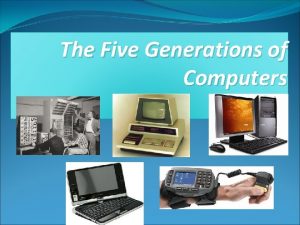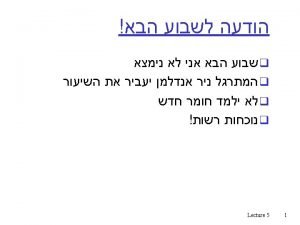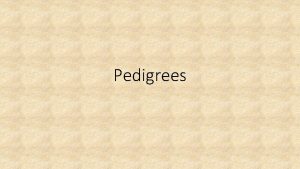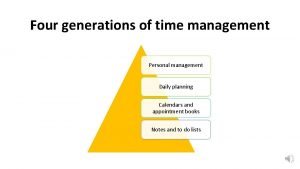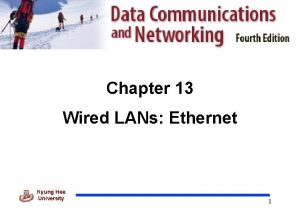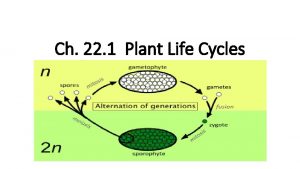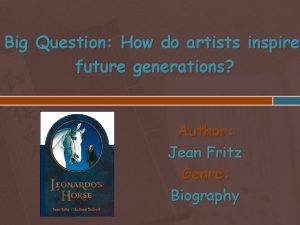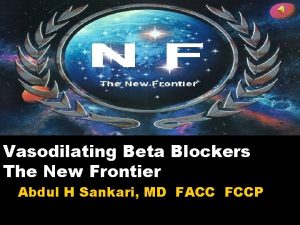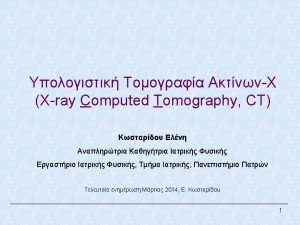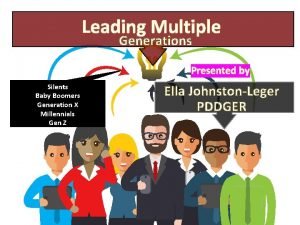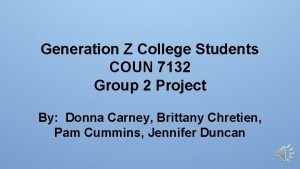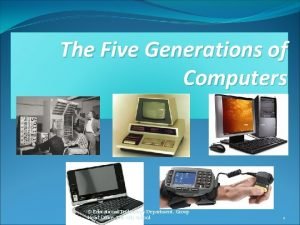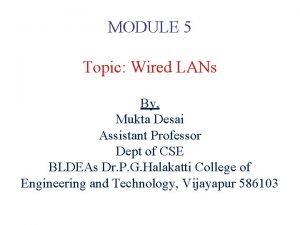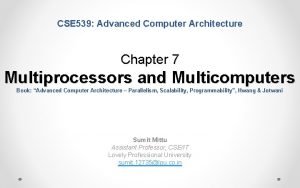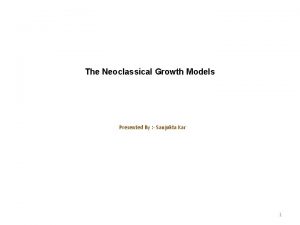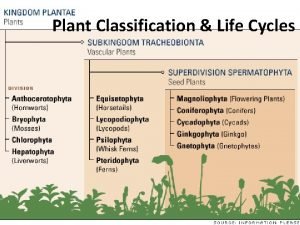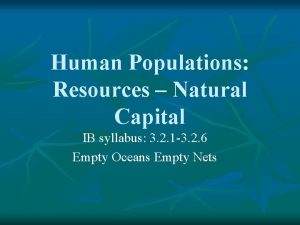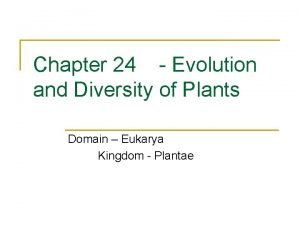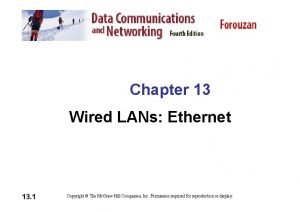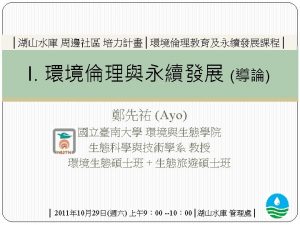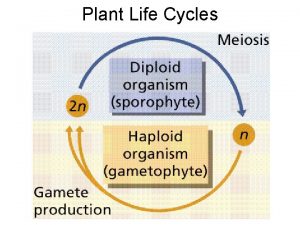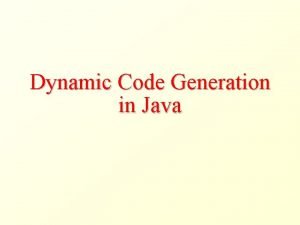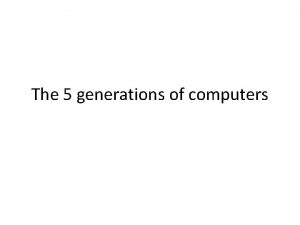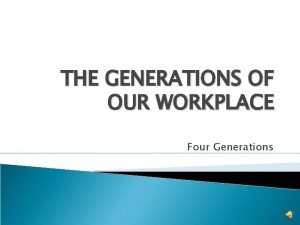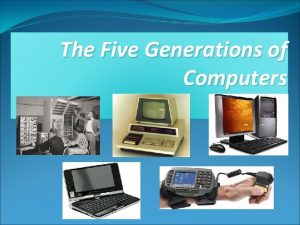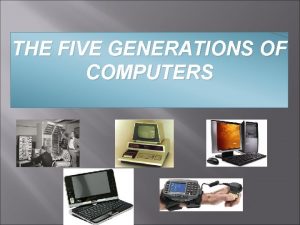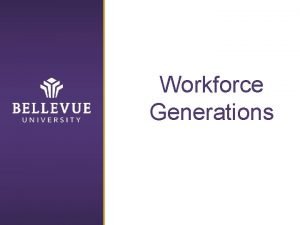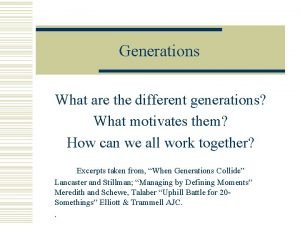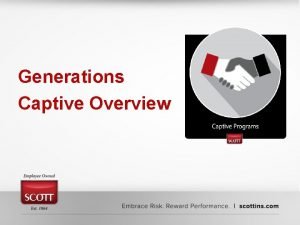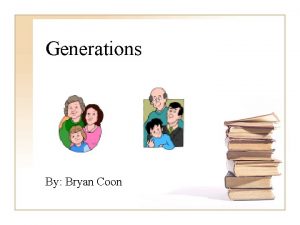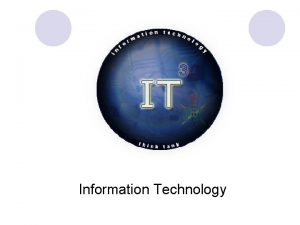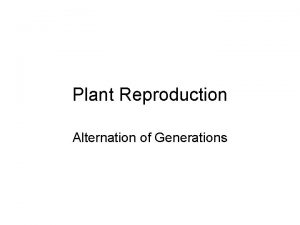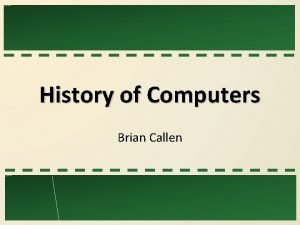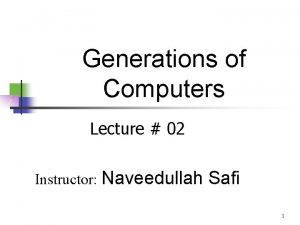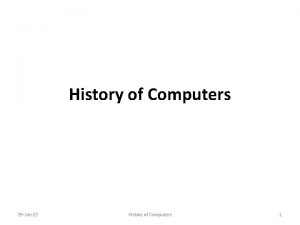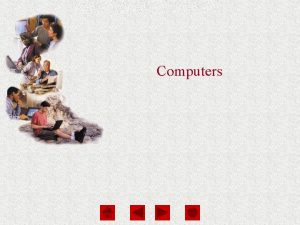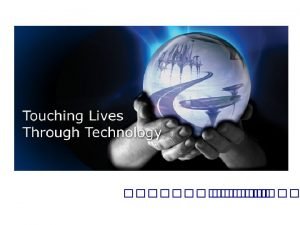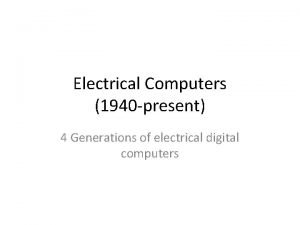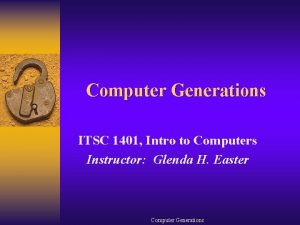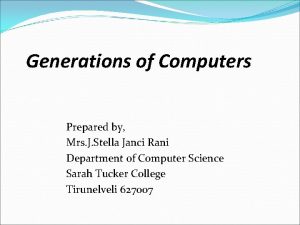Lecture 1 History Of Computers Generations Of Computers








































- Slides: 40

Lecture 1 History Of Computers Generations Of Computers Assignment # 1

Pre-Computing Counting on fingers n Counting Pebbles n Counting marks on the walls n Counting marks on the bones n Counting marks in the sand n


Computer Prehistory n Abacus(3000 B. C) ¨ Considered to be the Original Counting Device. ¨ Simple device used to perform calculations ¨ Slide the Beads up and down on the rods to add and subtract. ¨ Relies on training, knowledge of user

Abacus. 3000 B. C n beads on rods to count and calculate n still widely used in China.

Computer Prehistory n Pascaline(1623 – 1662) ¨ Invented by Blaise Pascal ¨ He invented it to help his father in tax collection. ¨ Gear-driven machine performing wholenumber addition & subtraction ¨ Pascal was only man who could make repairs

Computer Prehistory n 17 th Century - Pascaline

Computer Prehistory n Jacquard’s loom(1801) ¨ Wove cloth, silk, and other materials ¨ Knots passing through the holes in cards created patterns woven into fabric

Early Computer Attempt n Charles Babbage(1793 – 1871) ¨ Considered to be Father of Computers because of his Impressive designs for ¨ Difference Engine ¨ Analytical Engine ¨ Difference n Engine huge calculator, steam driven & never finished

Early Computer Attempt n Analytical engine ¨ Designed by Charles Babbage ¨ Similar to early computers Could store up to 1000 50 -digit numbers n Could run more complex programs than early machines at a rate of 60 Additions/sec n accurate to six decimal places n

Early Computer Attempt n Analytical engine ¨ Steam power turned handles n Wouldn’t need humans to run ¨ Design would cover the area of a football field.

Binary Machines n Konrad Zuse develops Z 1(1936) ¨ First automatic calculator based in binary ¨ First Programmable computer designed to solve complex engineering Equations.

Binary Machines n 1936 --- Konrad Zuse develops Z 1 ¨ Contained memory to remember 64 numbers ¨ Each multiplication took 5 seconds

Electronic Computers n ABC Computer(1939 -1942) ¨ First electronic, digital computer ¨ Built by John Atanasoff & Clifford Berry ¨ Performed complicated mathematical computations ¨ Original notes for design written on the back of a cocktail napkin

Electronic Computers n ABC Computer(1939 -1942) ¨ Weighed 800 lbs, used 300+ vacuum tubes, & 1 mile of wire ¨ Each calculation took 15 seconds

Electronic Computers n Mark I Computer(1944) ¨ Developed by Howard Aiken & IBM ¨ Could add, subtract, multiply and divide Included subroutines to compute logarithms and trigonometric functions. n It had switches which when flipped back and forth, represented mathematical data. n

Electronic Computers n Mark I Computer ¨ Weighed 5 tons, 55’ long, 8’ high ¨ Stored 72 numbers ¨ 3 additions/second; ¨ 3 - 5 seconds per multiplication

Electronic Computers n ENIAC Computer(1943 -1946) ¨ Electronic Numerical Integrator and Computer ¨ To compute trajectory table for US army. ¨ Programs set by external switches and dials n Took weeks to physically reprogram machines

Electronic Computers n ENIAC Computer ¨ Weighed 30 tons 17, 460 vacuum tubes n 5 million soldered joints n ¨ Performed 5000 additions, 357 multiplications or 38 divisions per second

Electronic Computers n ENIAC Computer Shortcomings ¨ Could only store and manipulate a limited amount of information. ¨ Programs were wired on boards. ¨ Thus, difficult to detect errors.

Electronic Computers n 1953 ¨ 701 released, IBM’s 1 st computer ¨ Stored 256 numbers in memory ¨ Only 19 ever made n Rented by businesses for $15, 000 per month ¨ IBM sold 1, 800 IBM 650 s, which worked with IBM punch card equipment, from 1954 -1962

Electronic Computers n 1953 701 released, IBM’s 1 st computer ¨ Performed 2200 multiplications per second ¨

1 st Generation Computers n EDVAC(1946 -1952) ¨ Electronic Discreet Variable Automatic Computer ¨ Based on Stored Program Concept. ¨ Stored data in binary form. n UNIVAC(1951) ¨ Universal Automatic Computer ¨ First fully electronic digital computer built in the U. S. ¨ Use of vacuum tubes

1 st Generation Computers n Advantages: ¨ These were the Fastest calculating devices of that time. n Disadvantages: ¨ Too bulky in Size. ¨ Excessive Heat Generation. ¨ Non-portable.

2 nd Generation n Used Transistors starting in 1956 Replaced vacuum tubes with Transistors, thus making it faster, smaller and reliable. Advantages: ¨ Less Heat Generation ¨ Smaller than 1 st Generation Computers. n Disadvantages: ¨ Costly ¨ Manual Assembly of individual components

PDP-8 Minicomputer n In 1963, PDP-8 was launched. n Small computers for business and specific applications.

3 rd Generation n Third Generation Computers used Integrated Circuits (chips). Integrated Circuits are transistors, resistors, and capacitors integrated together into a single “chip”. Advantages: ¨ Smaller in size, easily portable, no need of manual assembly of individual components. n Disadvantages: ¨ Highly sophisticated technology required.

4 th Generation Over 30, 000 components were integrated onto a single chip. n Performed 60, 000 instructions per second. n The First Microprocessor (Intel 4004) n ¨ The 4004 had 2, 250 transistors. ¨ 108 Khz ¨ Called “Microchip” (Specialized chip for memory and logic)

4 th Generation n Advantages ¨ Smallest in size. ¨ Heat generation is negligible. ¨ Much faster in computations. ¨ Cheapest. n Disadvantages ¨ Highly sophisticated technology required.

Birth of Personal Computers(1975) n MITS ALTAIR ¨ ¨ ¨ Could hold 256 numbers in RAM Required TV for use as a display Did not include any software (even an OS) Owner had to put machine together Cost $400 Small company, Microsoft, formed by 2 college kids to sell BASIC compiler for Altair

Growth of the Home Computer n Apple I(1976) Could store 8192 numbers (8 KB) in memory ¨ Included keyboard, but needed TV for display ¨ Cost $666. 66 per machine ¨ Less powerful than Altair but also less expensive and complicated. ¨

Growth of the PC n Apple II(1977) ¨ Contained 4 KB of memory ¨ First personal computer to include color graphics (included 16 colors!), but still needed TV for monitor ¨ Built-in Keyboard

Player Enters the Market n IBM PC (1981) ¨ First PC fully built from off-the-shelf parts and commercially available operating system

Player Enters the Market n IBM PC(1981) ¨ Used 4. 77 MHz processor ¨ Default had 16 KB of memory, but could be expanded to 256 KB ¨ Color monitor was optional ¨ Cost $1565

Updated Computer Line n Apple IIe (1983) ¨ Used 1 MHz processor ¨ Included 64 KB of memory ¨ Cost $1400 per machine ¨ Became one of the best selling computers of all time

Personal Computer Revolution n Apple Lisa (1983) 1 st GUI-based home computer ¨ Used 5 MHz processor, 512 KB of memory, 5 MB hard drive ¨ 12” monitor ¨ Cost $9995 ¨ Apple Macintosh released in 1984 ¨

Personal Computer Revolution 1983 – Apple Lisa released n 1984 – Apple Macintosh released n

Other Important Computer Dates n 1983 – Intel releases 80386 ¨ Speed---16 MHz 1983 – 10 million computers used in US n 1986 – 30 million computers used in US n 1989 – Intel releases 80486 n ¨ 25 MHz ¨ First Intel chip capable of multiprocessing

Pentium Series n In 1995 Pentium-Pro Microprocessor ¨ Windows 95 OS ¨ n In 1997 Intel announces Multimedia capabilities ¨ Pentium II(333 MHz Speed) ¨ n In 1998 ¨ n Windows 1998 OS. In 1999 ¨ Pentium III (Graphics Friendly)

Assignment 1 n Discuss the growth of PCs from year 2000 to 2005 in terms of Hardware improvement and Operating Systems. n Discuss Von-Neumann's Architecture.
 First generation computers
First generation computers 01:640:244 lecture notes - lecture 15: plat, idah, farad
01:640:244 lecture notes - lecture 15: plat, idah, farad Todays generations
Todays generations Three generations of packet switches
Three generations of packet switches Bonding agents
Bonding agents Generations in a pedigree
Generations in a pedigree Pedigree representation
Pedigree representation Future generations collaborative
Future generations collaborative 4 generations of time management
4 generations of time management Fern life cycle steps
Fern life cycle steps Generations overview
Generations overview Wired lans ethernet
Wired lans ethernet Alternation of generations in plants
Alternation of generations in plants Inspire future generations
Inspire future generations Generations of beta blockers
Generations of beta blockers Generations
Generations Let's preserve it for future generations
Let's preserve it for future generations Generations in order
Generations in order Fourth generation computer
Fourth generation computer 1995 generation
1995 generation Ethernet evolution through four generations
Ethernet evolution through four generations Come lord jesus come and be born in our hearts
Come lord jesus come and be born in our hearts Five generation of computer
Five generation of computer Ethernet evolution through four generations
Ethernet evolution through four generations Three generations of multicomputers
Three generations of multicomputers Rotary international
Rotary international Unit 1 generations
Unit 1 generations Overlapping generations model
Overlapping generations model Generations of supraglottic airway devices
Generations of supraglottic airway devices Alternation of generations
Alternation of generations Sustainable development future generations
Sustainable development future generations Sustainable development future generations
Sustainable development future generations Alternation of generations
Alternation of generations Ethernet evolution through four generations
Ethernet evolution through four generations Hvad er bioethanol
Hvad er bioethanol A plant's life cycle alternates between and generations.
A plant's life cycle alternates between and generations. Sustainable development future generations
Sustainable development future generations Plant life cycles and alternation of generations
Plant life cycles and alternation of generations Nicolas generations
Nicolas generations Java dynamic code generation
Java dynamic code generation History also history physical
History also history physical
